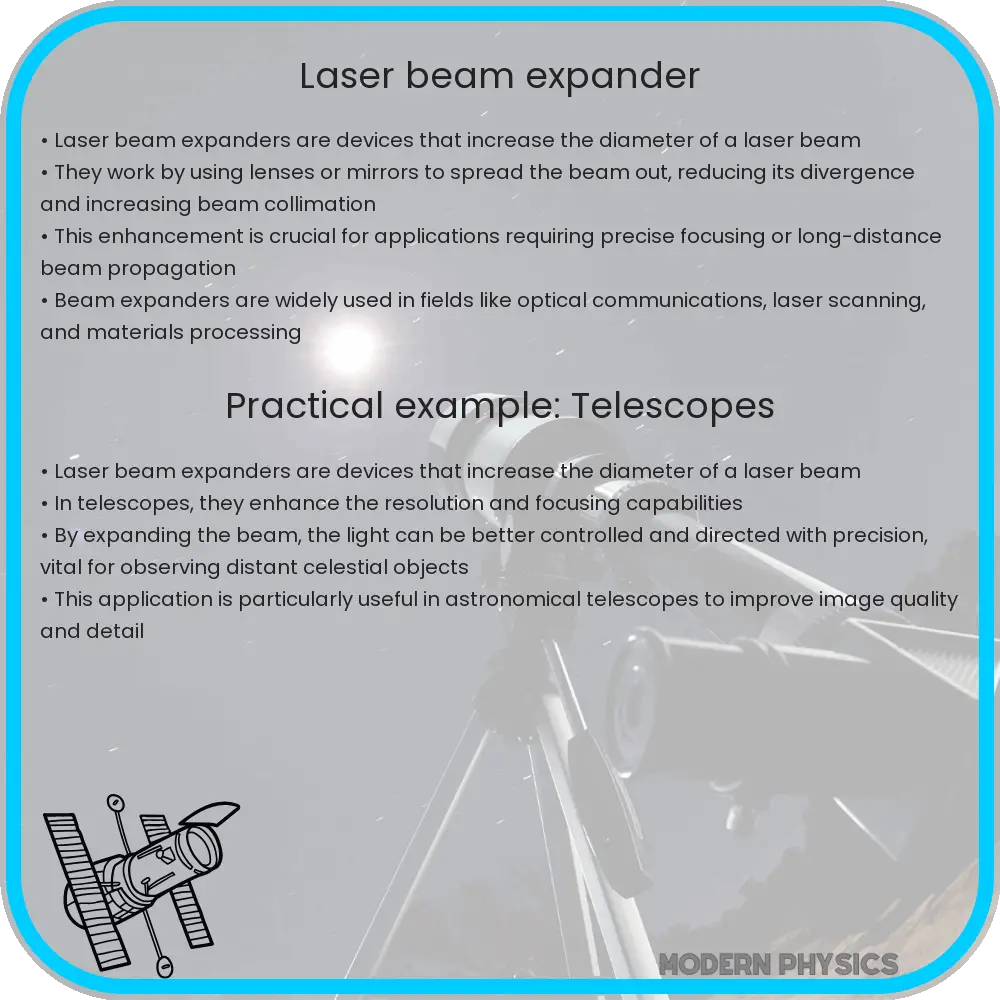Explore the role of laser beam expanders in enhancing precision, scalability, and optical design for applications in laser machining and microscopy.

Laser Beam Expanders: Enhancing Precision and Scalability in Optics Design
Laser beam expanders play a crucial role in the field of optics, offering enhanced precision and scalability for a wide range of applications, from precision machining to scientific research. These devices, designed to increase the diameter of a laser beam, are pivotal in improving beam quality, reducing divergence, and facilitating the accurate delivery of laser energy over long distances.
Understanding the Mechanics of Beam Expansion
At their core, laser beam expanders are composed of two or more lenses that work together to modify the beam’s diameter. The design principles are akin to those of telescopes, utilizing Galilean or Keplerian configurations. A Galilean beam expander, for example, features a negative input lens and a positive output lens, offering the advantage of a compact design without the need for internal focus, thus minimizing the risk of laser-induced damage. Conversely, the Keplerian model employs two positive lenses, resulting in an inverted image and necessitating an internal focal point where beam divergence can be adjusted.
Key Components and Material Considerations
The choice of materials and the precision in the manufacturing of the optical components are critical to the performance of laser beam expanders. Lenses must be crafted from materials with high optical clarity and minimal absorption at the laser’s wavelength to prevent thermal damage and maintain beam integrity. Common materials include fused silica for ultraviolet (UV) and visible light applications, and zinc selenide (ZnSe2) or germanium (Ge) for infrared (IR) lasers.
Applications and Scalability
Laser beam expanders find their utility in a multitude of applications, ranging from laser scanning and cutting to telescopic observation and interferometry. Their scalability is particularly beneficial in settings requiring precise control over beam diameter and focus, such as in material processing where larger beams distribute energy more evenly, or in long-distance communication systems where expanded beams can travel farther with less divergence.
The integration of laser beam expanders into optical systems thus not only enhances the precision of laser applications but also opens up new avenues for scalability and efficiency in both industrial and research environments.
Laser Beam Expanders: Enhancing Precision and Scalability in Optical Design
Laser beam expanders play a pivotal role in the field of optics by magnifying the diameter of a laser beam, enhancing precision in various applications ranging from microscopy to laser machining. These devices are fundamental in improving the performance and versatility of laser systems, catering to the demanding requirements of modern optical design.
Understanding Laser Beam Expanders
At their core, laser beam expanders are optical assemblies that modify the size and divergence characteristics of laser beams. The design typically involves two or more lenses, with the primary lens collimating the incoming laser light and the secondary lens focusing it to the desired diameter. This process not only increases the beam diameter but also reduces its divergence, leading to a more collimated beam over longer distances.
Components and Materials
The choice of materials and components in beam expanders is crucial for achieving high precision and durability. Lenses made from high-quality optical glasses or crystals, such as fused silica or ZnSe, are common due to their low absorption and high thermal stability. Coatings on the lenses also play an essential role in minimizing losses and enhancing transmission at specific laser wavelengths.
Design Considerations for Scalability
Designing a laser beam expander requires careful consideration of scalability, allowing for adjustments in magnification to accommodate different applications. This scalability is achieved through adjustable or fixed designs. Adjustable expanders offer the flexibility to change the expansion ratio, suitable for tasks requiring variable beam sizes. Conversely, fixed expanders provide a constant magnification factor, optimized for applications where stability and simplicity are paramount.
Applications in Precision Optics
Laser beam expanders find their application in a myriad of high-precision optical setups. In laser machining, they enable focused beams to achieve cleaner cuts with minimal kerf. In microscopy, expanded beams provide uniform illumination, crucial for high-resolution imaging. Additionally, in optical communication, they enhance signal quality over long distances by reducing beam divergence.
Conclusion
The integration of laser beam expanders into optical systems marks a significant advancement in the pursuit of precision, scalability, and efficiency in laser applications. By carefully selecting materials, optimizing design for scalability, and tailoring to the specific requirements of the application, beam expanders significantly enhance the capabilities of laser systems. As technology progresses, the continued innovation in the design and application of laser beam expanders will undoubtedly play a crucial role in the evolution of optical sciences, driving forward the boundaries of what is achievable in precision laser applications.
